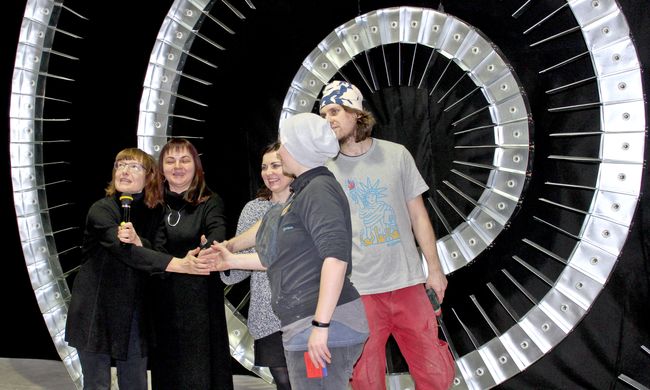“A challenge to contemporary theatrical Kharkiv”
Ermilov Center hosts a high-profile exhibit dedicated to Les Kurbas
A tightly-packed Ermilov Center, a lot of young people and historians, a large group of Kharkiv actors and producers, and unique items – from audio recordings to reconstructed set designs and costumes… The start of the exhibit “Les Kurbas in Kharkiv” showed: the contemporary city of theaters remembers the “wise Harlequin.”
“WITHOUT KHARKIV, THERE WOULD NOT HAVE BEEN THE KURBAS WE KNOW”
Project curator Virliana Tkach, an American drama producer with Ukrainian roots, says: “By this exhibit we are trying to answer the question: what did Les Kurbas do? You should perceive it not only visually, but also by hearing and reading in order to understand his first steps towards modernism in the theater both in Kyiv and in Kharkiv. Without Kharkiv, there would not have been the Les Kurbas we know, I am very pleased that we could come here and learn so much about his work. I first came here when Roman Cherkashyn [actor, Les Kurbas’ friend. – Author] was still alive, and he opened a whole world to me! The exhibit will help understand that-time Kharkiv and Kurbas’ theater.”
Waldemar Kliuzko did the exhibit’s design. The Museum of the Ukrainian Theater, Music, and Cinema has sent a large number of items which actors of Kyiv’s Berezil began to collect. “This is the first time I am in Kharkiv. I knew that they were working wonders, and I’ve appreciated this space at last. It is really fabulous. This kind of installation could have been made here only,” Kyivite Tetiana Rudenko says, showing a specially reconstructed scenic design of the production “Hello, You’re on Wave 477,” and adds: “1929 has come back in a way. You can see unique things.” Incidentally, not only a set design was made, but also the song “Kharkiv, Kharkiv,” a jazz anthem of the city, was recorded for this production. A considerable part of visual exhibits are coupled with audio – for example, you can use the available earphones to hear the voice of Yosyp Hirniak, one of the leading actors in the production People’s Malakhii. In 1960 he read on New York’s radio the first act of the play Kharkiv theatergoers had seen in 1928. On the whole, a lot of artists and museums, including foreign ones, were involved in staging the exhibit. The Fulbright Program in Ukraine has also rendered assistance.
ONE-HANDSHAKE ACQUAINTANCE
It is Kyivites who brought the Les Kurbas exhibit to Kharkiv – even the huge reconstructed stage scenery was manufactured in the capital. But Kharkivites, particularly actors of the Kharkiv Taras Shevchenko Theater (the smaller stage of which is called Berezil) that Kurbas founded in 1922, did not stand aside.
Actress Tetiana Turka requested to be given at least some work, for she could not help participating in this event. “The artistic director of the exhibit, Waldemar, suggested that I paint the wall black. And I did it. I painted a black square. It was such a pleasure, for I knew what I was doing this for. The exhibit is wonderful! Virliana Tkach is an innovator. What she is doing is very valuable for Ukraine. For people know and speak very much about the Kyivan period of Les Kurbas’ theater but, unfortunately, very little about the Kharkiv period,” the actress says. In her words, all those who touched on Kurbas continued to follow his esthetics to the end of their lifetime.
For example, stage director Oksana Stetsenko confessed: “I was acquainted with Kurbas through one handshake.” She was a student in the late 1980s, when it was allowed to speak about Kurbas and even put on his productions. “I was taught by actor Les Serdiuk, a pupil of Kurbas, who played Mokii in the first production of Myna Mazailo. Serdiuk showed students a lot of mise-en-scenes and told us what Kurbas had said. I was a friend and admirer of Serdiuk. At 86, he still flitted like a butterfly, showing how Mokii told in Kurbas’ production about Ukrainization.” If we recall that Les Kurbas considered movement, not word, to be the basis of the theater, demanded that actors flawlessly control their body, and believed that sport and acrobatics were compulsory in the training of actors, it becomes clear why his theater’s actor, aged 86, was in an excellent physical form and “flitted like a butterfly,” recalling the way he used to play on the Berezil stage.
It is planned to give art lectures and show Kurbas’ productions in a reconstructed scenography as part of the exhibit.
You can get immersed in the theatrical atmosphere of the 1920s until February 25.
Newspaper output №:
№6, (2018)Section
Time Out





